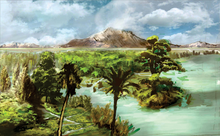Danian
| Danian | |||||||||||||
|---|---|---|---|---|---|---|---|---|---|---|---|---|---|
| Chronology | |||||||||||||
The Danian is the oldest age or lowest stage of the Paleocene Epoch or Series, of the Paleogene Period or System, and of the Cenozoic Era or Erathem. The beginning of the Danian (and the end of the preceding Maastrichtian) is at the Cretaceous–Paleogene extinction event 66 Ma. The age ended 61.6 Ma, being followed by the Selandian.[5]
Stratigraphic definitions The Danian was introduced in scientific literature by junior synonym and is no longer in use.[7]
The base of the Danian is defined at the foraminiferans repopulated the Paleocene seas after the Cretaceous mass extinction (Olsson et al., 1996). The first replacement foraminiferan of the Paleogene is the Globigerina eugubina, which is used to define the base of the Danian Age (Stainforth et al., 1975). This foraminiferan replaced the Cretaceous genus Globotruncana.
The top of the Danian Stage (the base of the Selandian) is close to the boundary between nanoplankton species Neochiastozygus perfectus.
The Danian Stage overlaps the Asian land mammal ages. It includes the oldest Mammal Paleogene zones, all included in the 1 - 5 group.[9]
PaleontologyThough the non-avian modern birds also survived, particularly in the area around Australia but also elsewhere, e.g. Scaniornis of the North Sea region. The oceans remained much the same as the Late Cretaceous seas, only that there was less life, few remaining marine reptiles (mostly turtles, choristodera and crocodiles ), and other lesser-known animals.
There are ammonites (mainly of the Scaphitidae class in Turkmenistan)[10] still being around at this time, although they did not survive the Danian age.[11]
Latest Danian EventClose to the end of the Danian, around 62.2 Ma, occurred a hyperthermal, similar to but smaller in magnitude compared to the more famous Palaeocene-Eocene Thermal Maximum (PETM),[12] known as the Latest Danian Event (LDE).[13] The event, which took place over a 170-230 kyr time interval,[14] is evidenced in the geologic record by two negative carbon isotope excursions and is believed to have led to a 2–3 °C (3.6–5.4 °F) warming of both deep and surface seawater.[15] This hyperthermal also led to a shallowing of the oceanic lysocline, as evidenced by the significant decrease in calcium carbonate preservation.[13]
References
LiteratureWikisource has original works on the topic: Cenozoic#Paleogene
External links
| |||||||||||||
